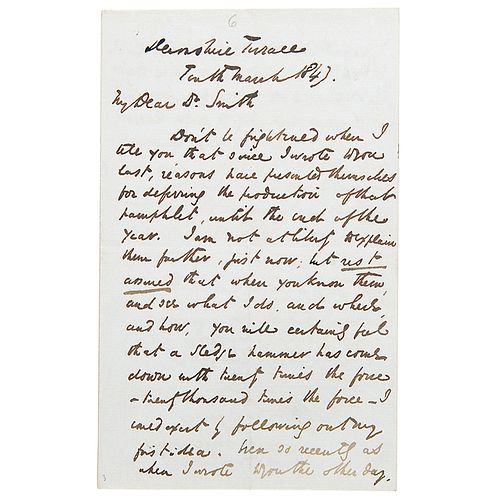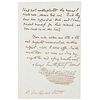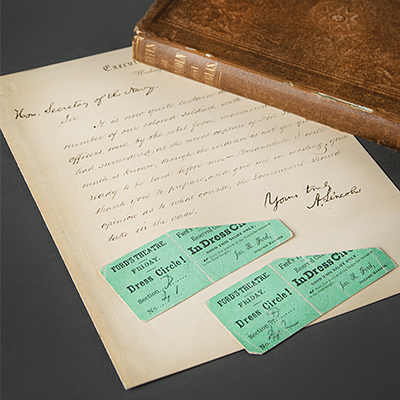Charles Dickens Letter on the Origin of A Christmas Carol (March 1843)
Two ways to bid:
- Leave a max absentee bid and the platform will bid on your behalf up to your maximum bid during the live auction.
- Bid live during the auction and your bids will be submitted real-time to the auctioneer.
Bid Increments
| Price | Bid Increment |
|---|---|
| $0 | $5 |
| $50 | $10 |
| $200 | $25 |
| $500 | $50 |
About Auction
Sep 23, 2023
RR Auction support@rrauction.com
- Lot Description
Extraordinary ALS from Charles Dickens encapsulating the moment he decided to write his famed novella A Christmas Carol. The handwritten letter, two pages on adjoining sheets, 4.5 x 7.25, March 10, 1843, addressed from his Devonshire Terrace home and sent to social reformer Thomas Southwood Smith. After corresponding for some time about sanitary conditions for working children in England, and deciding to publish a pamphlet exposing the scandal, Dickens here writes with a change of plan, in full:
“Don’t be frightened when I tell you that since I wrote to you last, reasons have presented themselves for depriving the production of that pamphlet until the end of the year. I am not at liberty to explain them further, just now, but rest assured that when you know them, and see what I do, and which and how, you will certainly feel that a sledge hammer has come down with twenty times the force — twenty thousand times the force — I could expect by following out my first idea. Even so recently as when I wrote to you the other day I had not contemplated the means I shall now, please God, use. But they have been suggested to me, and I have girded myself for their seizure, as you shall see in due time. If you will allow our tete a tete and projected conversation on this subject, still to come off, I will write to you as soon as I see my way to the end of my month’s work.” In fine condition.
The inception of A Christmas Carol was the result of the 1842 publication, Report of the Children’s Employment Commission, and its subsequent second part that was released in February the following year. Compiled by Dickens’ friend Richard Henry Horne, the reports detailed the extreme, unhealthy, dangerous, and exploitative working conditions many poor children were forced to endure in the UK, a plight Dickens had experienced firsthand growing up.
With his family in debtors’ prison, 12-year-old Charles was removed from school and sent to Warren’s Shoe Blacking Factory, where he spent six days per week pasting labels on jars of shoe polish for a weekly pay of six shillings. Beyond having to endure long work hours at a monotonous task, he also was subjected to appalling work conditions, including intermittent physical abuse. The release of the second report stirred up in Dickens past memories and a desire for action, which, initially, he planned to express in a philosophical “pamphlet” with the proposed title ‘An Appeal to the People of England on behalf of the Poor Man’s Child.’ A few days later, Dickens changed his mind, scrapping his “first idea” in favor of something different: a ghost story.
Four weeks after visiting the Ragged School for destitute children in September 1843, Dickens began writing A Christmas Carol, simultaneously whilst ‘pegging away, tooth and nail’ at Martin Chuzzlewit, then being serialized monthly. He completed the work in a mere six weeks and A Christmas Carol was published on December 19, 1843, with the original run of 6,000 copies sold out by Christmas and 13 official editions published by the end of the following year. An astonishing letter penned by Dickens at the very moment of inspiration. - Shipping Info
-
Bidder is liable for shipping and handling and providing accurate information as to shipping or delivery locations and arranging for such. RR Auction is unable to combine purchases from other auctions or affiliates into one package for shipping purposes. Lots won will be shipped in a commercially reasonable time after payment in good funds for the merchandise and the shipping fees are received or credit extended, except when third-party shipment occurs. Bidder agrees that service and handling charges related to shipping items which are not pre-paid may be charged to a credit card on file with RR Auction. Successful international Bidders shall provide written shipping instructions, including specified Customs declarations, to RR Auction for any lots to be delivered outside of the United States. NOTE: Declaration value shall be the item’(s) hammer price and RR Auction shall use the correct harmonized code for the lot. Domestic Bidders on lots designated for third-party shipment must designate the common carrier, accept risk of loss, and prepay shipping costs.
-
- Buyer's Premium



 EUR
EUR CAD
CAD AUD
AUD GBP
GBP MXN
MXN HKD
HKD CNY
CNY MYR
MYR SEK
SEK SGD
SGD CHF
CHF THB
THB










![[LIMITED EDITIONS CLUB] 2 vols. The House of Mirth, Diary of Country Priest](https://s1.img.bidsquare.com/item/m/2979/29793737.jpeg?t=1TN7Db)
![[LIMITED EDITIONS CLUB] Dürrenmatt, Friedrich. Oedipus. Photogravure plates by Marie Cosindas](https://s1.img.bidsquare.com/item/m/2979/29793752.jpeg?t=1TN7Wl)

